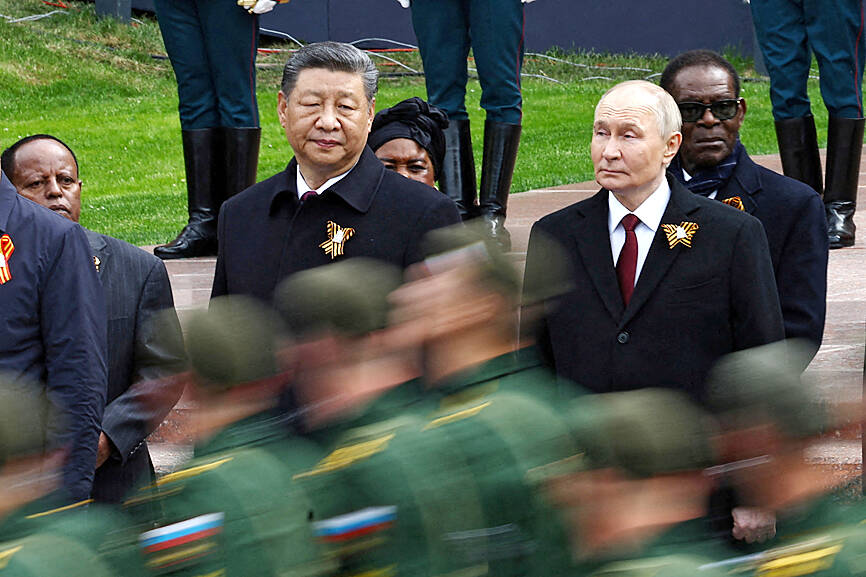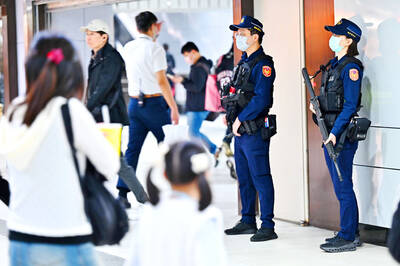Russia is selling military equipment and technology to China that could help Beijing prepare an airborne invasion of Taiwan, according to an analysis of leaked Russian documents by a UK-based defense and security forum.
The Royal United Services Institute’s (RUSI) analysis is based on about 800 pages of documents, including contracts and lists of equipment to be supplied by Moscow to Beijing, from the Black Moon hacktivist group, which previously published some of the documents online. It does not identify its members, but describes itself in a manifesto as opposed to governments that carry out aggressive foreign policy.
The authors of the RUSI report shared some of the documents with The Associated Press and say they appear to be genuine, although parts of the documents might have been omitted or altered. AP is unable to independently verify their authenticity.

Photo: REUTERS
The mix of completed and apparent draft Russian documents reference meetings between Chinese and Russian delegations — including visits to Moscow — and payment and delivery timelines for high-altitude parachute systems and amphibious assault vehicles. They suggest that Russia has begun work on the products to be delivered, but do not contain direct evidence from the Chinese side that Beijing has paid any money or received any equipment.
The authors argue the equipment could be used to invade Taiwan. Under Chinese President Xi Jinping (習近平), China has embarked upon a broad modernization program of its armed forces with the goal of transforming it into a “world-class” military by 2050.
High-ranking US officials have suggested that Xi ordered his military to be prepared for a possible invasion of Taiwan as early as 2027.
The documents do not mention Taiwan directly, but the analysis by the London-based institute suggests the deal would help China gain advanced parachuting capabilities that it would need to mount an invasion, potentially speeding up a timeline.
It is not certain that China has decided to invade Taiwan, but access to Russian equipment and localized training in China means Beijing would be better equipped for a potential invasion, said RUSI associate fellow Oleskandr Danylyuk, who coauthored the report.
“The Chinese school of airborne landing is very young,” he said, adding that Moscow’s assistance could help speed up China’s airborne program by about 10 to 15 years.
Russia’s Kremlin, and China and Taiwan’s defense and foreign ministries did not immediately respond to requests for comment.
“The greatest value of the deal” to China is likely in the training and procedures for command and control of parachute forces, because Russia has “combat experience,” whereas China does not, wrote Danylyuk and coauthor RUSI senior research fellow Jack Watling.
Russia’s aim is to develop as a military supplier to China and fund its war in Ukraine, they said, while Danylyuk also suggested that Moscow might want to draw Beijing into a conflict with Washington over Taiwan, distracting the US from Russia’s war with Ukraine.
While Beijing’s military capabilities largely surpass Moscow’s, the analysis says China has gaps which Russia can fill. Russia has a long history of airborne forces dating back decades, knowhow the authors say China needs.
Song Zhongping (宋忠平), a military commentator in Beijing, said China had superior equipment, but “Russia has more combat experience.”
Sung Wen-ti (宋文笛), an expert on China and Taiwan with the Atlantic Council, said parachuting in forces would probably support the logistics of any invasion, but would be unlikely to be the “main event.”
Instead, “China is playing the long game” by acquiring Russian equipment, Sung said.
That is because Beijing would find a way to reverse engineer the equipment and technology, and develop it not just for airborne combat, but also for advanced intelligence, surveillance and reconnaissance, which are critical for modern warfare, he said.
According to a document dated September last year, an initial 2021 agreement detailed timelines for payments and delivery.
Stages 1 and 2 — an analysis of technical specifications, software modifications and equipment manufacturing — have been completed, the document said.
Russia also agreed to provide training in China and a complete set of equipment for an airborne battalion, including the ability to carry out infiltration by special forces, the RUSI report said.
That includes the sale of 37 light amphibious assault vehicles, 11 amphibious anti-tank self-propelled guns and 11 airborne armored personnel carriers, as well as command and observation vehicles, it said.
The total cost was more than US$210 million, it added.
Beijing wants all of the vehicles to be equipped with Chinese communications systems and to be prepared to use Chinese ammunition, the report said.
Russia also agreed to sell China systems that are designed for parachuting up to 190kg from extremely high altitudes, it said.
The documents reference the minutes of a meeting from March 8 last year in Moscow in which Russia agreed to provide China by the end of last year with details of how the system, known as Dalnolyot, performed temperatures as low as minus-60°C.
Beijing requested testing the parachute systems for drops from 8km, a height that would allow Chinese forces to glide for up to 80km, allowing “Chinese special forces groups to penetrate the territory of other countries without being noticed,” the report said.
Danylyuk said that the Dalnolyot system could be used for a “stage zero” landing in Taiwan, in which Beijing secretly sends in equipment and special forces from aircraft outside Taiwanese airspace.
Although Russia has a long history of parachute troops, Moscow has not deployed them successfully in Ukraine.
In February 2022, just days after Russian President Vladimir Putin ordered the full-scale invasion of Ukraine, his special forces soldiers tried to take over Hostomel airfield on the outskirts of Kyiv.
They planned to establish a base to fly in more troops, but several Russian helicopters were hit by missiles before they even got to Hostomel. An attempt to take control of a military airbase south of Kyiv also failed.
Western officials and military experts said that the failure to establish an air bridge from Russia to Ukraine turned what Moscow expected to be a swift victory into a grueling war of three years and counting.
Now Moscow has dipped into its Soviet-era stocks to replace weapons on the battlefield and, like Ukraine, is ramping up its weapons production.
However, that does not mean Moscow is unable to sell equipment to China, Danylyuk said.
The airborne equipment described in the documents was necessary only for “the invasion stage,” he said.
Russia does not need such equipment for Ukraine, he said.
The analysts wrote that China’s “operational challenge” in Taiwan would be to do what Russia could not: Suppress Taiwan’s air defenses, and land sufficient troops and equipment to be able to build up a force to defeat the Taiwanese military before it mobilizes.
The report said that China could do that by airdropping armored vehicles on golf courses near Taiwanese ports and airfields, which could allow air troops to clear a path for landing forces.

TRAGEDY STRIKES TAIPEI: The suspect died after falling off a building after he threw smoke grenades into Taipei Main Station and went on a killing spree in Zhongshan A 27-year-old suspect allegedly threw smoke grenades in Taipei Main Station and then proceeded to Zhongshan MRT Station in a random killing spree that resulted in the death of the suspect and two other civilians, and seven injured, including one in critical condition, as of press time last night. The suspect, identified as a man surnamed Chang Wen (張文), allegedly began the attack at Taipei Main Station, the Taipei Fire Department said, adding that it received a report at 5:24pm that smoke grenades had been thrown in the station. One man in his 50s was rushed to hospital after a cardiac arrest

A car bomb killed a senior Russian general in southern Moscow yesterday morning, the latest high-profile army figure to be blown up in a blast that came just hours after Russian and Ukrainian delegates held separate talks in Miami on a plan to end the war. Kyiv has not commented on the incident, but Russian investigators said they were probing whether the blast was “linked” to “Ukrainian special forces.” The attack was similar to other assassinations of generals and pro-war figures that have either been claimed, or are widely believed to have been orchestrated, by Ukraine. Russian Lieutenant General Fanil Sarvarov, 56, head

SAFETY FIRST: Double the number of police were deployed at the Taipei Marathon, while other cities released plans to bolster public event safety Authorities across Taiwan have stepped up security measures ahead of Christmas and New Year events, following a knife and smoke bomb attack in Taipei on Friday that left four people dead and 11 injured. In a bid to prevent potential copycat incidents, police deployments have been expanded for large gatherings, transport hubs, and other crowded public spaces, according to official statements from police and city authorities. Taipei Mayor Chiang Wan-an (蔣萬安) said the city has “comprehensively raised security readiness” in crowded areas, increased police deployments with armed officers, and intensified patrols during weekends and nighttime hours. For large-scale events, security checkpoints and explosives

PUBLIC SAFETY: The premier said that security would be tightened in transport hubs, while President Lai commended the public for their bravery The government is to deploy more police, including rapid response units, in crowded public areas to ensure a swift response to any threats, President William Lai (賴清德) said yesterday after a knife attack killed three people and injured 11 in Taipei the previous day. Lai made the remarks following a briefing by the National Police Agency on the progress of the investigation, saying that the attack underscored the importance of cooperation in public security between the central and local governments. The attack unfolded in the early evening on Friday around Taipei Main Station’s M7 exit and later near the Taipei MRT’s Zhongshan